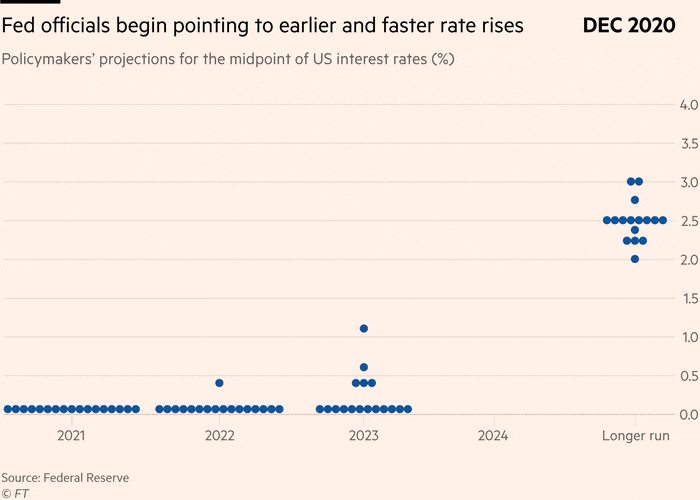
Raising US interest rates will not cause recession, says top Fed official
 John Williams, president of the New York Fed, said inflation was ‘too high’ © Bloomberg
John Williams, president of the New York Fed, said inflation was ‘too high’ © Bloomberg We’ll send you a myFT Daily Digest email rounding up the latest US interest rates news every morning.
The US central bank is “very focused” on taming “too high” inflation and will be able to do so without causing a recession, according to a senior Federal Reserve official.
John Williams, president of the New York Fed, endorsed the central bank’s decision this week to accelerate the scaling back of its asset purchase programme so that the stimulus ends altogether in March.
Calling it “exactly the right thing to do”, he said it gave the Fed the flexibility to more substantively tighten monetary policy next year.
“It’s really about getting our monetary policy stance in a good position, and also obviously creating the optionality, at some point next year likely, to actually start raising the federal funds target range,” Williams said in an interview with CNBC.
According to new projections released by the Fed this week, officials expect three interest rate increases in 2022, followed by a further three in 2023. A two-notch adjustment is also pencilled in for 2024, bringing the main policy rate closer to 2 per cent.

The forecasts suggest a dramatically faster pace of interest rate rises next year than Fed officials were anticipating when they last released projections three months ago.
They come after strong economic data and clearer signs that inflation is becoming a more persistent problem, spreading into sectors beyond those most sensitive to pandemic-related disruptions.
“We’re very focused on inflation; it is obviously too high right now,” Williams said on Friday. “We want to make sure inflation comes back down to our 2 per cent longer-run goal.”
Current market pricing suggests that, by taking an aggressive stance early to counteract mounting price pressures, the Fed will be limited in its ability to raise rates significantly later on as economic growth falters.
Implied rates on Sofr and Eurodollar contracts between 2024 and 2026 now hover under 1.5 per cent, well below the long-run 2.5 per cent target expected by a majority of Fed officials.
Williams provided some reassurance on Friday, saying that he felt “confident” the Fed could deliver “stable low inflation” without causing a sharp contraction in economic growth.
He said higher interest rates should actually be taken as an indication of how strong the economy is.
“I go into next year feeling [like] the baseline outlook is a very good one,” he said. “Therefore, actually raising interest rates would be a sign of a positive development in terms of where we are in the economic cycle.”
Williams predicts continued “strong improvements” in the labour market, which is beginning to regain its momentum. The unemployment rate now sits at 4.2 per cent.
Fed officials expect it to drop to 3.5 per cent next year, with the inflation rate still elevated at 2.7 per cent and the economy expanding at 4 per cent.
Get alerts on US interest rates when a new story is published
Get alerts // Snippet copied with modification from: // https://support.google.com/surveys/answer/6172863?hl=en&ref_topic=6172724 (function() { var ARTICLE_URL = window.location.href; var CONTENT_ID = 'everything'; var scriptEl = document.createElement('script'); scriptEl.src = '//survey.g.doubleclick.net/survey?site=_ykzfqallocklxfmrw3y6sankbe' + '&url=' + encodeURIComponent(ARTICLE_URL) + (CONTENT_ID ? '&cid=' + encodeURIComponent(CONTENT_ID) : '') + '&random=' + new Date().getTime() + // This loads survey scripts which do not use document.write()! '&after=1'; document.head.appendChild(scriptEl); })();Copyright The Financial Times Limited 2021. All rights reserved.Reuse this content (opens in new window) CommentsJump to comments sectionPromoted Content- Global Economy Add to myFT
- US Inflation Add to myFT
- US interest rates Add to myFT
- Central banks Add to myFT
- Federal Reserve Add to myFT
Owl Media Group takes pride in providing social-first platforms which equally benefit and facilitate engagement between businesses and consumers and creating much-needed balance to make conducting business, easier, safer, faster and better. The vision behind every platform in the Owl Media suite is to make lives better and foster a healthy environment in which parties can conduct business efficiently. Facilitating free and fair business relationships is crucial for any thriving economy and Owl Media bridges the gap and open doors for transparent and successful transacting. No advertising funds influence the functionality of our media platforms because we value authenticity and never compromise on quality no matter how lucrative the offers from advertisers may seem.
Originally posted on: https://www.ft.com/content/6c6b6c99-9e46-406d-a7f7-39b509542097